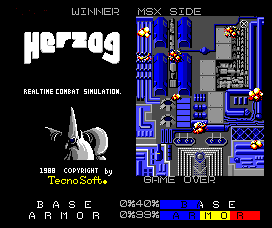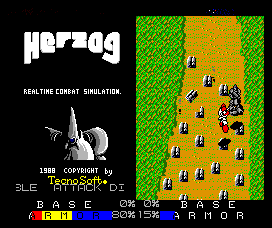Retro Replay Review
Gameplay
Herzog delivers a fresh twist on the real-time strategy formula by unfolding along a narrow, vertical playfield rather than the traditional two-dimensional map. As commander of a hovering battlemech, you oversee a continuous flow of units marching from your base toward the enemy stronghold. This linear battlefield transforms every skirmish into a tense push-and-pull, as you balance defensive duties near your home base with opportunistic advances toward the opposition.
Unlike later RTS titles that emphasize base construction and resource harvesting, Herzog preconfigures your headquarters at both ends of the map. Your primary role is to purchase units—ranging from foot soldiers and tanks to anti-air batteries—with funds earned through combat. Once deployed, these units automatically advance toward the foe, but you can personally pick up a single enemy of interest (or up to five friendly soldiers) and reposition them to tip the scales in crucial moments. This mechanic adds an arcade-like immediacy to the strategy, melding click-and-command with direct action.
An overhead radar strips away unnecessary clutter, granting instant situational awareness of both allied and hostile forces. As your vision narrows to firefights between mechs, infantry, and armored vehicles, that simple radar becomes your lifeline, allowing you to anticipate enemy raids and adapt your purchases accordingly. Timing is everything: delay reinforcements too long, and your front lines collapse; overspend early, and you risk being outgunned in the decisive phase.
Another standout feature in Herzog’s gameplay is the periodic clash of mechs. When the enemy’s battlemech emerges in force, it’s not just a screen-filling bruiser but an opportunity for a shoot ’em up encounter within an RTS setting. These mech-on-mech duels demand quick reflexes and strategic positioning, transforming the pace from measured resource management to adrenaline-fueled dogfight. The resulting blend of macro-level planning and micro-level combat engagement remains uniquely compelling even by modern standards.
Graphics
Given its 1988 release, Herzog’s visuals are charmingly retro yet remarkably functional. The sprites are modest in detail, but each unit type—infantry, tanks, AA guns, and the colossal mech—possesses a distinct silhouette that reads clearly against the sparse terrain. This clarity is vital for quick decision-making, ensuring you never mistake a slow-moving tank for a nimble soldier.
The battlefield stretches vertically across a plain backdrop, punctuated only by the rectangular bases at either end and the intermittent grid lines that hint at distance traveled. This minimalistic design might feel bare compared to contemporary RTS titles, but it helps focus attention squarely on the action. Subtle animations—tanks reloading, soldiers firing, and mechs stomping—add life to the scene without overwhelming the hardware.
Color usage is restrained yet purposeful: each faction has its own palette, making it easy to distinguish friend from foe even in the heat of battle. The HUD is equally straightforward, with a compact radar at the top, a fund counter, and mech health indicators. While not a graphical showcase, Herzog’s aesthetic serves the gameplay with no wasted visual noise, harking back to a time when clarity trumped clutter.
For enthusiasts of vintage game art, Herzog’s look offers a nostalgic glimpse into the era’s design constraints and creativity. Modern emulations and fan remakes sometimes include higher-resolution sprites and smoother animations, but purists will appreciate the original’s pixel-perfect presentation and the way it laid groundwork for more elaborate RTS visuals to follow.
Story
Herzog unfolds in a war-torn region recently reshaped by conflict. The dissolution of old alliances gave birth to a new state called Ruth, a land whose fragile sovereignty is immediately threatened by internal strife. A sudden military coup forces the peace-loving faction known as the Mercies into a fight for survival, setting the stage for your campaign.
While Herzog’s narrative is not delivered through lengthy cutscenes or branching dialogue, its premise effectively contextualizes every skirmish. Each advance of your battlemech and stream of troops toward enemy lines feels like reclaiming ground for a beleaguered nation. The minimalist storytelling invites players to project their own interpretations onto the conflict, deepening investment in the wipeout-or-win stakes.
The game’s text-based briefing screens, concise mission goals, and intermittent status updates from the front help sustain a sense of purpose. Though simple by modern standards, this approach aligns well with Herzog’s streamlined gameplay. There’s no time wasted on elaborate exposition—every mechanic and mission is directly tied to reclaiming Ruth’s independence.
In retrospect, Herzog’s narrative laid groundwork for more immersive RTS storylines that would soon follow in titles like Dune II and Warcraft. Its fusion of strategy and personal mech combat gives the tale a unique flavor, framing each play session as a microcosm of a nation’s struggle rather than a mere sequence of skirmishes.
Overall Experience
Playing Herzog today is like unearthing a strategic time capsule. Its pioneering vertical battlefield and mech-centric combat feel refreshingly different from both its contemporaries and modern RTS blockbusters. The marriage of strategy and direct-action sequences keeps the tempo varied, rewarding both careful planning and hands-on skill.
Newcomers might find the graphics and sound modest, but those who appreciate historical significance will be captivated by Herzog’s role in shaping the RTS genre. The straightforward interface, coupled with the pick-up-and-play nature of the mech commands, ensures a low barrier to entry even for players unfamiliar with vintage titles.
Repeated plays reveal deeper strategic possibilities: deciding when to invest in anti-air defenses, timing your mech raids to intercept enemy funds, and mastering the delicate art of platoon airlifts to press advantages. Though the campaigns are relatively short, the emergent scenarios and fast-paced duels encourage multiple runs, especially for those seeking high-score bragging rights or the perfect tactical execution.
Overall, Herzog remains an informative and enjoyable experience for retro-gaming enthusiasts and strategy historians alike. Its blend of linear RTS progression, direct combat, and clean presentation offers a distinct flavor that stands apart from anything else. If you’re curious about the origins of modern real-time strategy or just in search of a concise, action-packed wargame, Herzog is well worth exploring.
 Retro Replay Retro Replay gaming reviews, news, emulation, geek stuff and more!
Retro Replay Retro Replay gaming reviews, news, emulation, geek stuff and more!









Reviews
There are no reviews yet.